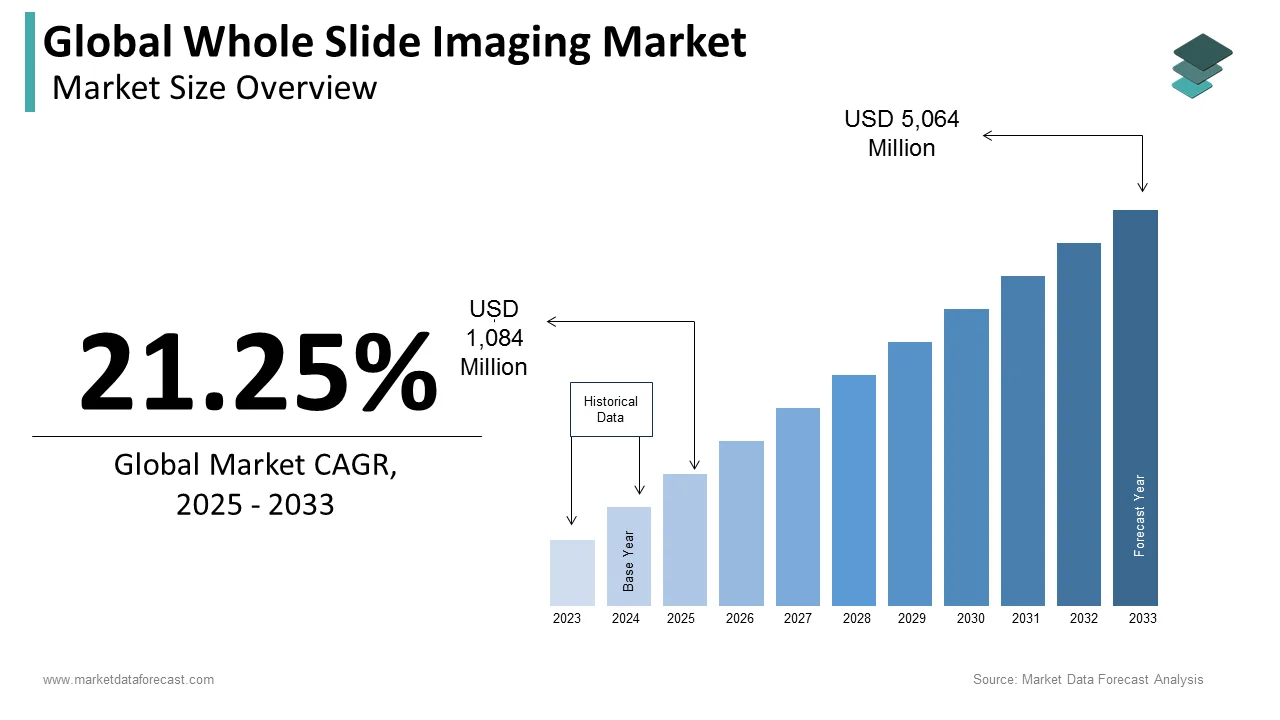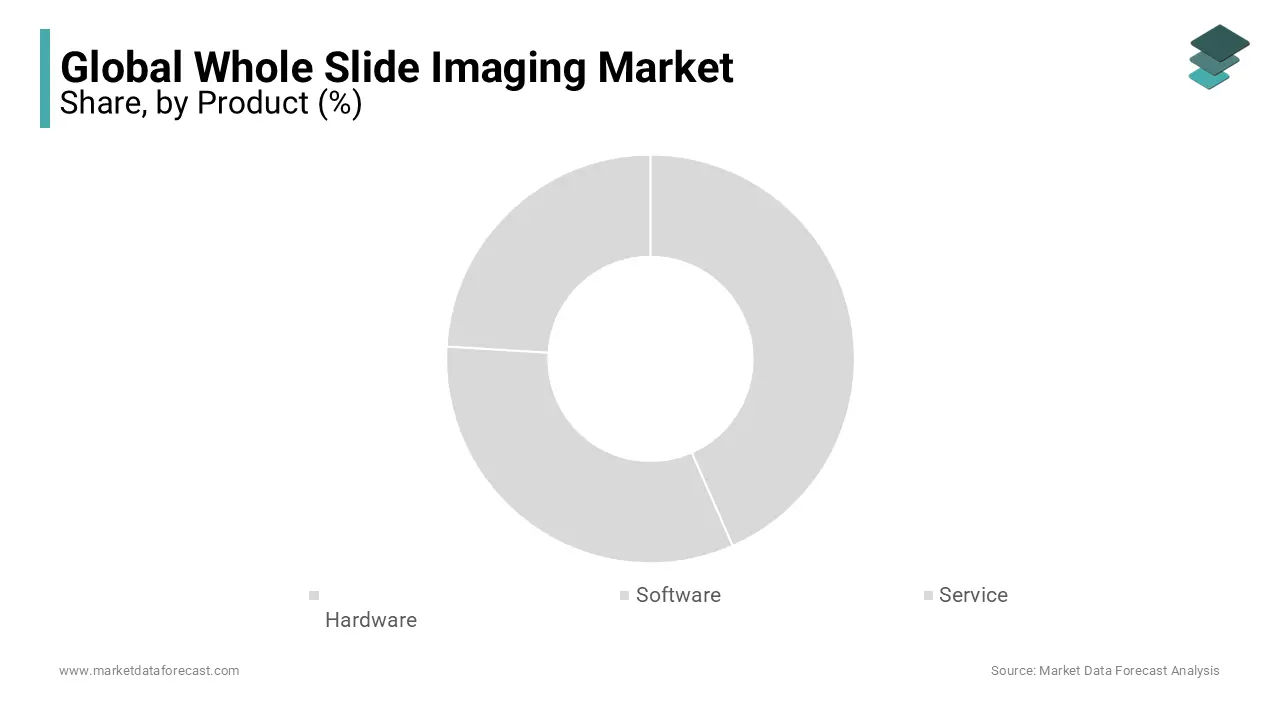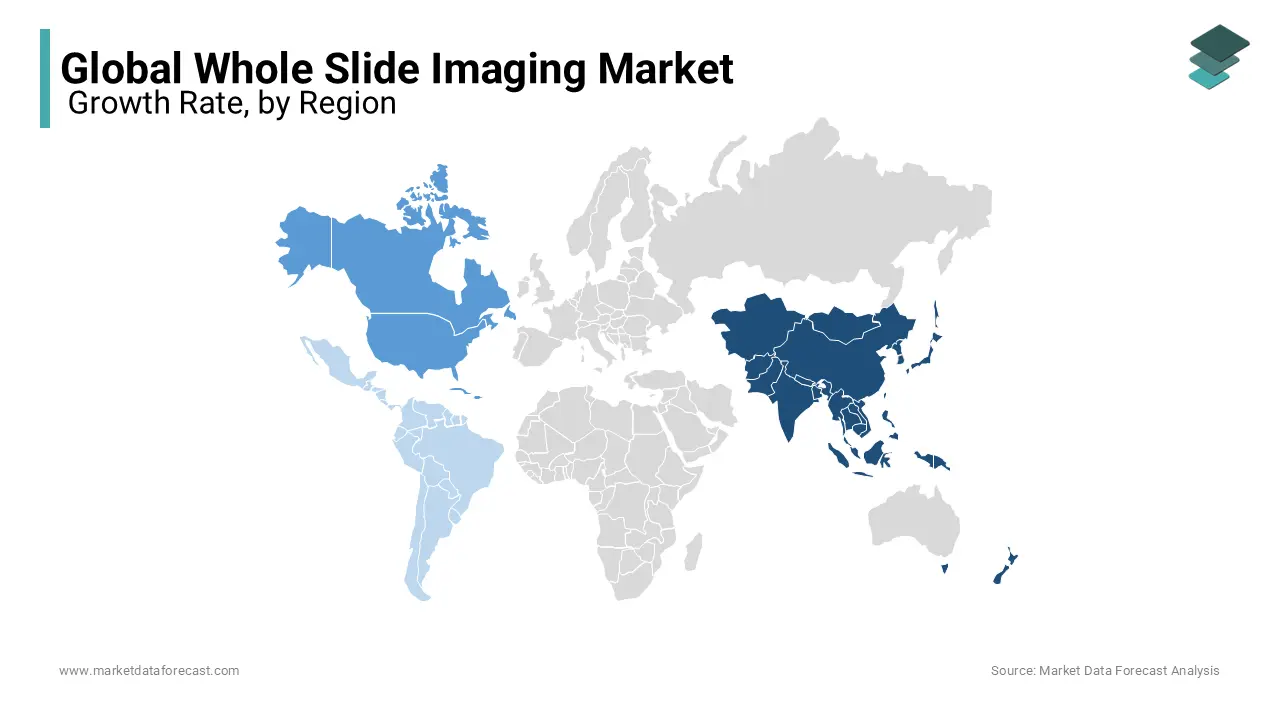Global Whole Slide Imaging Market Size, Share, Trends & Growth Forecast Report By Product, Application, End-User & Region (North America, Europe, APAC, Latin America, Middle East and Africa), Industry Analysis (2025 to 2033)
Global Whole Slide Imaging Market Size
The global whole slide imaging market size was valued at USD 894.02 million in 2024 and this value is expected to be worth USD 5,064 million by 2033 from USD 1,084 million in 2025, growing at a CAGR of 21.25% from 2025 to 2033.

MARKET DRIVERS
The growing prevalence of chronic diseases, the growing number of technological developments in whole slide imaging, and the growing adoption and demand for digital pathology propel the global whole slide imaging market growth. The whole slide Imaging is used mainly for clinical purposes. All slide images are primarily used to view pathology slides remotely. Digital pathology is increasing day by day due to an increase in advanced technology, such as data transfer speeds, advances in software, and cloud storage solutions. As a result, pathology departments have started using digital imaging for image preservation and image analysis. Recently, pathology laboratories have designed whole slide imaging facilities, which are used in various applications in diagnosis and research.
Furthermore, fast image acquisition, efficient data storage, repeatable data analyses across experiments, automated analyses, and easy and instantaneous data sharing drive the whole slide imaging market forward. Advanced digital scanners, visualization methods, and the integration of artificial intelligence-derived algorithms with these systems provide opportunities for the whole slide imaging market to accelerate further. Based on concepts of artificial intelligence and deep learning, an OS-SiA scanner is built to identify the cell area.
MARKET RESTRAINTS
On the other hand, the high installation and maintenance costs and some other technical issues are restraining the growth of the slide imaging market. In addition, limited technologies, digital slide storage, and problems with scanning material and image quality are significant challenges to the whole slide imaging market.
Impact of COVID-19 on the Global Whole Slide Imaging Market
The COVID-19 pandemic has accelerated the growth rate of the whole slide imaging market. The COVID-19 pandemic has spread worldwide, resulting in the closure of many industries, including hospitals. Transportation and supply chains have been disrupted due to lockdowns. The COVID-19 pandemic has driven the growth of the whole slide imaging market due to the adoption of digital pathology for remote pathology diagnoses. This technology helps pathologists remotely care for patients from anywhere in the world. Due to the COVID-19 pandemic, telehealth has become more popular; digital whole slide imaging can send the computer-generated scan right to the telehealth team for a clear view of the patient’s problem. It provides a clear image without compressing the image. Due to the COVID-19 pandemic, many academic teaching methods have changed in institutions to stop the spread of the novel coronavirus. This resulted in increasing digital pathology education tools during the COVID-19 era. Teaching in pathology using digital teaching materials gives students a higher quality image and good interaction. As a result, considering all these factors, the market has had favorable growth during this pandemic period.
REPORT COVERAGE
|
REPORT METRIC |
DETAILS |
|
Market Size Available |
2024 to 2033 |
|
Base Year |
2024 |
|
Forecast Period |
2025 to 2033 |
|
CAGR |
21.25% |
|
Segments Covered |
By Product, Application, End-user, and Region. |
|
Various Analyses Covered |
Global, Regional, and country-level analysis; Segment-Level Analysis, DROC; PESTLE Analysis; Porter’s Five Forces Analysis, Competitive Landscape; Analyst Overview of Investment Opportunities |
|
Regions Covered |
North America, Europe, APAC, Latin America, Middle East & Africa |
|
Market Leaders Profiled |
Philips, Siemens, Positron Corporation, Agfa-Gevaert N.V., CardiArc Ltd., Digirad Corporation, Gamma Medica Inc., GE Healthcare, Hologic Inc., Leica Microsystems GmbH, Nikon Corporation, Visiopharm, 3Dhistech, Hamamatsu Photonics KK, Indica Labs., and Others. |
SEGMENTAL ANALYSIS
Global Whole Slide Imaging Market Analysis By Product
The hardware segment accounted for the largest share of the global whole slide imaging market in 2024. This segment is further anticipated to continue showing domination throughout the forecast period owing to the acceptance of a wide range of appearance functionality and an increasing number of product innovations. This helps to speed up the scanning process for imaging.

Global Whole Slide Imaging Market Analysis By Application
The cancer segment led the whole slide imaging market with the largest share in 2024 due to the increasing number of cancer cases and advanced treatments. In 2021, nearly 11 million people died due to cancer disease. The most common cancers are breast, lung, colon and rectum, and prostate. This cancer is caused due to increasing consumption of tobacco use, alcohol consumption, and lack of physical activity. Whole slide imaging is used for cancer diagnosis for clear digital images for further decisions.
Global Whole Slide Imaging Market Analysis By End-User
The pharmaceutical & biopharmaceutical companies’ segment registered the highest share of the global whole slide imaging market in 2024 owing to the increasing investments in drug discovery and the growing launch of new products. Whole slide imaging is used to know the relationship between various biological features.
REGIONAL ANALYSIS
The Asia Pacific led the market, accounting for a significant share of the global whole slide imaging market in 2022. Because using whole slide imaging advanced technology and e-learning and tele-education in this region drive the market forward. China dominated the APAC whole slide imaging market in 2022. Cloud-based telepathology systems have been used in China due to the shortage of pathologists in hospitals. This device uses dual video and data drives to solve the problem of complex data interaction in telemedicine. It is used for quality diagnosis for Chinese people. There are 9840 licensed pathologists in China, according to statistics from the National Ministry of Health. In recent years all types of Whole slide imaging scanners have been available in Japan, each with a unique format.

In 2021, the North American whole slide imaging market had a substantial global market share. With the increasing number of medical errors and deaths in the United States every year, they adopted this Whole Slide Imaging system to reduce medical errors and give accurate patient data, driving the market in this region. Approval from the US FDA for a whole slide imaging system to use in primary surgical pathology diagnosis created a wide range of acceptance and application of this technology in this region. In addition, the Canadian Academy of Pathology has virtual books used in different cases for teaching purposes.
During the forecast period, the European whole slide imaging market is anticipated to showcase a promising CAGR. The Latin American region is predicted to register a moderate CAGR during the forecast period.
KEY PLAYERS IN THE GLOBAL WHOLE SLIDE IMAGING MARKET
Companies playing a dominating role in the global whole slide imaging market profiled in this report are Philips, Siemens, Positron Corporation, Agfa-Gevaert N.V., CardiArc Ltd., Digirad Corporation, Gamma Medica Inc., GE Healthcare, Hologic Inc., Leica Microsystems GmbH, Nikon Corporation, Visiopharm, 3Dhistech, Hamamatsu Photonics KK, and Indica Labs.
RECENT HAPPENINGS IN THE GLOBAL WHOLE SLIDE IMAGING MARKET
- In 2021, Royal Philips launched new AI-enabled innovations in MR imaging. It is used to speed up MR exams and to improve diagnostic quality.
- Leica Biosystems announced that it had received approval from the U.S. FDA to use Aperio WebViewer for remote diagnosis during the COVID-19 pandemic 2020.
DETAILED SEGMENTATION OF THE GLOBAL WHOLE SLIDE IMAGING MARKET INCLUDED IN THIS REPORT
This research report on the global whole slide imaging market has been segmented and sub-segmented based on product, application, end-user, and region.
By Product
- Hardware
- Scanners
- Viewers
- Image Management System
- Software
- Service
By Application
- Telepathology
- Cytopathology
- Immunohistochemistry
- Hematopathology
- Cancer
- Cardiology
By End-User
- Biotechnology and Pharmaceutical Companies
- Academic and Research Institutes
- Hospitals and Clinics
By Region
- North America
- Europe
- Asia-Pacific
- Latin America
- Middle East and Africa
Frequently Asked Questions
What was the size of the whole slide imaging market worldwide in 2024?
The global whole slide imaging market size was valued at USD 894.02 million in 2024.
What is the CAGR of the Whole slide imaging market in Europe?
The North American whole slide imaging market size is anticipated to grow by USD 640.49 million by 2032.
Which region in the global market accounted for the major share in 2024?
Geographically, the APAC region registered the leading share among all the regions in the global whole slide imaging market.
Related Reports
Access the study in MULTIPLE FORMATS
Purchase options starting from $ 2500
Didn’t find what you’re looking for?
TALK TO OUR ANALYST TEAM
Need something within your budget?
NO WORRIES! WE GOT YOU COVERED!
Call us on: +1 888 702 9696 (U.S Toll Free)
Write to us: [email protected]
